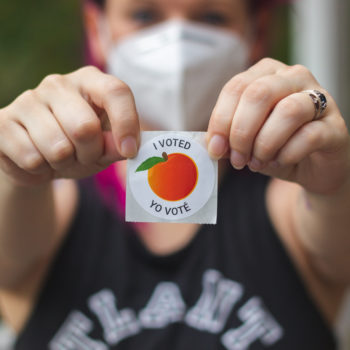Proportional Representation in Eastpointe, Michigan
In 2017, the United States Justice Department sued Eastpointe, MI under the Federal Voting Rights Act. As a result of this lawsuit, in their 2019 elections, Eastpointe residents will vote using ranked-choice voting (RCV) and elect their city council under a new voting system called proportional representation (PR).
History of the lawsuit
and why PR was adopted.
The city of Eastpointe, MI had a serious problem: despite a significant African American population, white candidates were the only candidates to ever win local elections. This occurred because the entire city got to vote in each city council race – City Council Position 1, City Council Position 2, City Council Position 3, City Council Position 4. In each of these races, 50% of the vote (plus one) was enough to win. This meant the white majority of the city had the votes to win every contest.
Lopsided election outcomes weren’t the only problem in Eastpointe, however. These are some quotations from the Department of Justice’s filing in federal court:
- Eastpointe has a history of official discrimination—including race-based residency restrictions—that effectively excluded black residents from Eastpointe for decades.
- Macomb County has a history of discrimination against black residents in areas including housing and public employment.
- The black population of Eastpointe continues to suffer from the effects of discrimination in education, policing, and employment, particularly municipal employment.
- Eastpointe elections have been marked by subtle and overt racial appeals, including a proposal to close streets connecting Eastpointe to the predominantly black City of Detroit.
- Social, civic, and political life in the City of Eastpointe remains divided along racial lines. This racial separation results in black candidates for city office having less opportunity than white candidates to solicit the votes of the majority of voters.
In response to the lawsuit, one remedy the city and DOJ considered was the creation of four single-member districts from which Eastpointe would elect their city councilmembers. Under this proposed remedy, one district would have been 2/3rds African American, ensuring that African Americans voting together would have had the power to elect a candidate of their choice in that district. The other three districts would have been 2/3rds white, where African American voters would never have the power to elect a candidate. That district map would have looked like this:
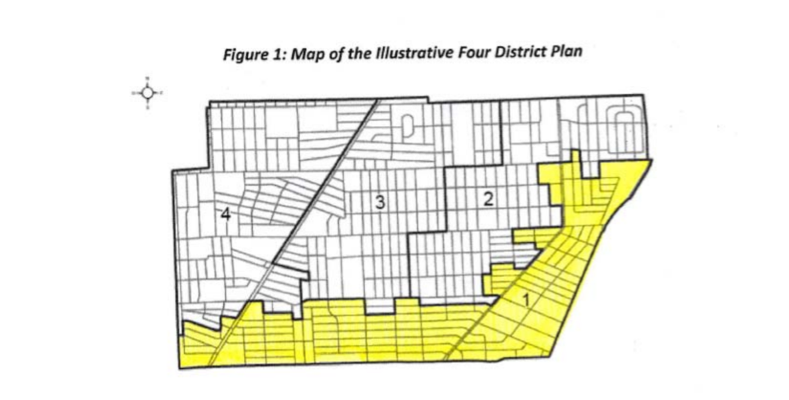
However, the city of Eastpointe is now 46% black. Though switching to a district system would ensure 1 of the 4 city councilmembers would be black, if Black People voted together, that would not be representative of the population. Moreover, adopting such a system would have implicitly designated one part of Eastpointe as “the black neighborhood,” while the other three districts would be “the white neighborhoods.” African Americans living in the white neighborhoods would know the election of white candidates from their districts were foregone conclusions.
Instead, the Department of Justice proposed something different: proportional representation. By using ranked-choice voting, where voters are allowed to rank candidates in the order they prefer (1st choice, 2nd choice, 3rd choice, and so on), elections outcomes will mirror how the city votes: the majority of the city will still win seats, but they won’t win all the seats.
Under this system, Black People in Eastpointe have the power to elect two of four city councilmembers. This is fair because Black People makeup almost half the city’s population. As an added benefit, it won’t matter where in the city residents live: they will all have the power to elect a candidate that represents them
Why RCV?
How does it help?
In most elections, voters are asked to pick one candidate, mark a vote for them, and move onto the next election. One problem with this method of voting is that it often fails to capture how people really feel. Often, a voter may really like one candidate, but also think another candidate is pretty good, and would be okay with another. Sometimes, voters only really don’t like one candidate.
Still others, voters might feel like they can’t vote for the candidate they like best, even though that candidate is their honest favorite, because they’re worried the candidate they like least will win. In this situation, voters often find themselves voting for a candidate that they don’t really like, but that they think has the best chance of defeating the candidate they’re worried about.
Ranked-choice voting addresses these problems by allowing voters to indicate support for candidates in order of preference: their first choice, who they like best, their second choice, who they may think is pretty good, and a third choice, who may be their least-favorite but still better than the alternative.
Here’s what the ballot looks like.
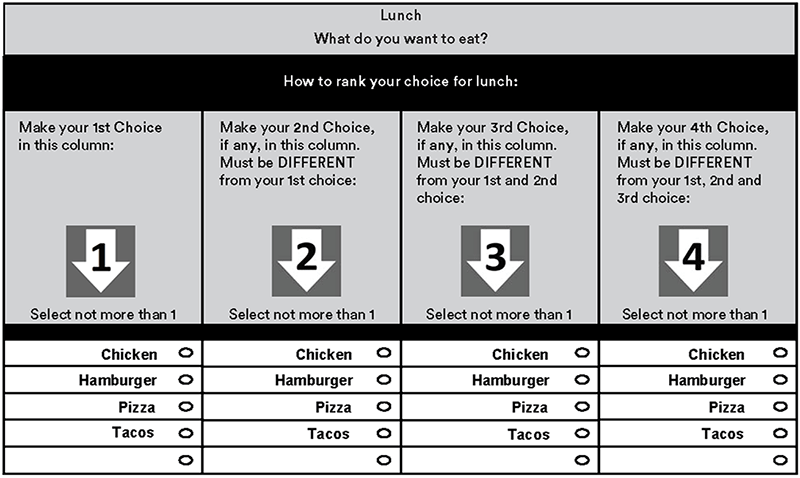
What ranked-choice voting means is that a voter can honestly support their favorite candidate, but if that candidate can’t win – perhaps because they’re a long-shot, or it’s a very close race and they don’t have quite enough votes – that person’s vote will instead count for their second-choice.
How does RCV and proportional representation work?
In Eastpointe, two city council candidates will be elected.
Under the old system, 50% of the vote (plus one) had the power to elect each candidate, which meant that the same group of voters elected all four city councilmembers while the African American population, 46% of the city, almost never elected any candidates.
Under proportional representation, all members of the city have the power to elect a candidate. Instead of running for individual positions (City Council Position 1, City Council Position 2), all candidates are running in one big pool for City Council. Now, instead of 50% of the vote (plus one) electing a candidate, 33% of the vote (plus one) has the power to elect a candidate. This gives all communities a chance to win a number of city council seats reflective of their size in the population.
Let’s look at a sample ballot.

Voters will select their favorite candidate as their first choice, and then indicate a second favorite candidate as their second choice. Ranked-choice voting is counted in rounds to ensure that as many votes as possible count in the election. When ballots are first tallied, only first choices are counted. This is important because it means indicating a second choice cannot hurt your first choice.
In each round, we check to see if any candidates have enough votes to win one of the two seats. Remember, 33% of the vote (plus one) is all it takes to win a seat. If any candidate has enough votes, they are immediately elected and we go to the next round. Remember, so far we are only counting voter’s first choices.
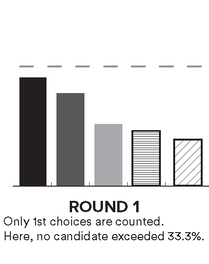
If no one has enough votes to win, we eliminate the candidate in last place, because they did not have enough support to win. Then, we go back to just the ballots that indicated the now-eliminated candidate was their first choice. Since that candidate is now out of the race, those ballots now go to whichever candidates were listed as their second choices.
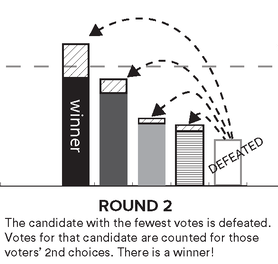
The next step in a proportional ranked-choice voting election is to look at a candidate that has more votes than they need to win. Votes beyond what a candidate needs to win are called “surplus votes.”
If a voter’s top-ranked candidate is elected and receives more votes than they need to win, each of that candidate’s voters has a portion of their vote count for the next person ranked on their ballot.
Why do we need to do this? Because the goal of proportional representation is to make sure the election outcomes reflect as closely as possible the will of the voters. Imagine if one candidate was so popular that they received 80% of the vote, more than double what they actually need to win. If we did not look at surplus votes, 20% of the city would elect the other city councilmember, which would obviously not reflect the will of the voters.
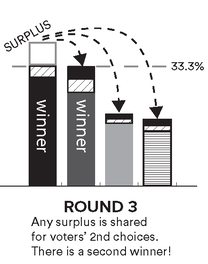
Both of these processes help make sure as many votes as possible count in the election. This process continues until both seats are filled or a ballot has no more ranked candidates.
Why does the process stop once two candidates are elected?
Once two candidates have the support of over 33% of the voters, over two thirds of voters are accounted for. All that leaves left are less than a third of voters, under 33%. This means it is not possible for them to push any other candidate to the minimum needed to win – 33% of the vote (plus one), and so the election concludes.
Ranked choice voting leads to more proportional representation because while larger voting groups still win the most seats, smaller voting groups are also able to elect a candidate of their choice. Other cities that use ranked choice voting in this way are Cambridge, MA and Minneapolis, MN.
RCV do's and don'ts
Make your voice heard.
DO

Your vote is your voice. If you have a favorite candidate, and have another candidate that you like a lot but that’s only your second choice, you should indicate so on your ballot. By doing so, your ballot will show how you truly feel and the odds you elect a candidate you support go up.
DON’T

Your second choice only ever goes into effect if your first choice is eliminated. If you list your favorite candidate as both, and that candidate is eliminated, your second choice is already eliminated and so can’t help that candidate.
DON’T

You are only allowed to mark one candidate as your first choice, one different candidate as your second choice, etc.. If you select more than one candidate for a given choice, your vote for that ranking and all subsequent rankings will not be counted.

